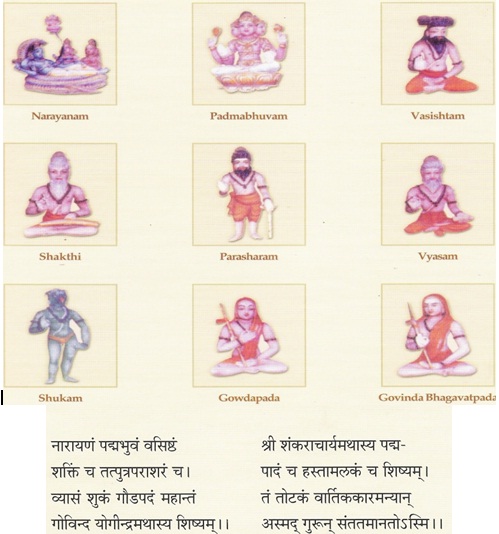Preceptors of Advaita 5 SUKA The truth of Advaita rests not merely on the inherent validity of the scriptures or the Vedas but on that of actual experience or anubhava. The Great Sankara Bhagavatpada, who is the foremost expounder of the truth of Advaita, clearly states in his commentary on the second Sutra of the Brahma-Sutra (janmadyasya yatah 1.1.2) that unlike in the case of Dharma the knowledge of Brahman rests also on experience (srutyadayah anubhavadayascha yathasambhavam iha pramanam). Again when discussing the possibility of the existence in this world of jivan-muktas or realised souls he emphasises that the only test for the existence of such realised souls in the human form is their own heart-experience, and such experience cannot be questioned by arguments about the possibility or not of the existence of jivan-muktas after they have destroyed their karmavasanas. Hence it is that Sankara postulates the necessity for initiation by a Guru for the realisation of the truth of Advaita. As a corollary to this proposition came the acceptance of a series of Gurus, who developed the Advaita-sampradaya. Before initiation into the study of Vedanta, everyone is expected to make a Santipatha, and in that one recites the Guru-parampara, from the beginning. God Narayana himself is the first Guru, next comes Brahma, next Vasishtha, then his son Sakti, then Sakti’s son Parasara, afterwards the son of Parasara, the great sage Vyasa, then his son Suka, afterwards Gaudapada, his sishya Govinda Bhagavatpada, and then his sishya Sri Sankara Bhagavatpada, and then his sishyas Hastamalaka, Suresvara, Padmapada, Totaka and others, and then downwards to one’s own Guru under whom one gets initiation into the study of Vedanta. We find therefore that Bhagavan Suka occupies a highly honoured place in our Guru-parampara. In this Guru-parampara, that has been handed down to us in the Advaita tradition, all the Gurus are, as will be seen, realised souls that have experienced the Advaita-tatva. When praising Vyasa the famous verse about him refers to him as the father of Suka(sukatatam taponidhim). This is a unique distinction for, usually, the name of the son is denoted by the name of his father. Here Vyasa is extolled by being mentioned as the father of Suka. This shows with what veneration the great devotees of Advaita Vedanta looked upon Suka. He is one of the greatest of Brahma-Nishthas. The story of suka’s wonderful birth and the way of his realisation of Brahman are very graphically narrated in the Mahabharata – Santi Parva-Adhyaya 323, and following Adhyayas. It is said therein that Bhagavan Vyasa performed a severe penance for begetting a son. He meditated on the great Siva. Pleased with his austerities God Siva blessed that a son would be born to him who would be pure as fire, air, earth, water and etheric space and that he would attain fame throughout the three worlds by his spirituality. Having attained this boon from Lord Siva, it is narrated that Vyasa began to produce fire from two sticks of wood (arani). At that time the beautiful celestial dancer Ghritachi appeared. Enslaved by kama on seeing her, Vyasa let fall his Virya on the fire produced from the sticks of wood, and out of it a son was born. As the Apsaras Ghritachi took the form of a parrot (suki) at that time, this son came to be known as Suka. This boy shone like effulgent fire and resembled Vyasa in his appearance. The child was later initiated into the study of the Vedas, and Vyasa instructed him in all Sastras. The child was also instructed by Brihaspati himself. Curiously enough in a short time the boy attained the knowledge of all branches of learning. But his mind did not move by the attractions of the other two asramas, of Grihastha and Vanaprastha. But he was intensely longing for Moksha. Hence his father Vyasa, advised him to go and study under the great Raja Rishi Janaka at Mithila. The Mahabharata specifically says that from the great asrama on the Himalayas, Suka came all the way to Mithila on foot, even though he had the power to fly over the intervening space between the Himalayas and Mithila. When he went to the palace of Janaka a discriminating gate keeper readily admitted him, struck by his attractive appearance. Suka was received in the palace by the ministers of Janaka and enjoyed the hospitality of the maids of the palace. Even then he had absolute self-control, and was indifferent to their attractions. In the morning Suka was received by Janaka and instructed in the path of Moksha. Then Janaka portrays to him beautifully the characteristics of a realised soul, how he is utterly devoid of jealousy and other evil qualities, how he looks upon all people with the same eye, how he is devoid of the opposites, praise and calumny, pleasure and pain, heat and cold, how he treats gold and iron as same, and how he has mastered the mind and indriyas. kirata hunandhrapulinda pulkasa
abhirakanka yavanah khasadayah ye anye cha papah yadupasrayasrayah sudhyanti tasmai prabhavishnave namah He also stresses that the Goal of all religious system is the realisation of God and the different margas expounded by those who have realised God is due only to their differences in the exposition of their experience due to the varying degrees of their intellectual perception. yadanghryanudhyanasamadhidhautaya
dhiyanupasyanti hi tattvamatmanah vadanti chaitat kavayo yatharucham sa me mukundo bhagavan prasidatam Bhagavan Suka thus expounded the great message of Bhakti as the royal road for all people irrespective of their intellectual attainment, for the realization of God. This Bhakti, the Bhagavata declares, is the be all and end all of life. But this Bhakti according to the Bhagavata must be inspired by tattajnana (the knowledge of the truth) and by the practice of vairagya accompanied by the pursuit of Rajayoga. Preceptors of Advaita - Other Parts:
|
